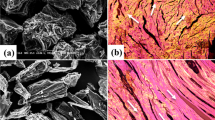Abstract
In this study, Needle and Regular coke, which has different crystalline and orientation characteristics, were graphitized, and the effect of crystal changes on electrochemical performance was investigated. The initial efficiency and capacity were mainly influenced by the shapes and specific surface areas of the particles, and the graphitized sample showed excellent initial efficiency due to having a lower specific surface area (decrease in exposed edge surfaces) than the coke. However, rate performance shows excellent in the graphitized sample of regular coke due to its defects and short lithium-ion transport path.
Graphic abstract









Similar content being viewed by others
References
Takehara ZI, Kanamura K (1993) Historical development of rechargeable lithium batteries in Japan. Electrochim Acta 38:1169–1177
Abraham KM (1993) Directions in secondary lithium battery research and development. Electrochim Acta 38:1233–1248
Ohms D, Kohlhase M, Benczúr-Ürmössy G, Schädlich G (2002) New developments on high power alkaline batteries for industrial applications. J Power Sources 105:127–133
Burke A (2008) Electric and hybrid vehicle design and performance. In: Kutz M (ed) Environmentally conscious transportation. Wiley, Chichester, pp 129–189
Arai J, Yamaki T, Yamauchi S, Maeshima T, Sakai T, Koseki M, Horiba T (2005) Development of a high power lithium secondary battery for hybrid electric vehicles. J Power Sources 146:788–792
Levi MD, Aurbach D (1997) Diffusion-coefficients of lithium ions during intercalation into graphite derived from the simultaneous measurements and modeling of electrochemical impedance and potentiostatic intermittent titration characteristics of thin graphite-electrodes. J Phys Chem B 101(23):4641–4647
Ohsaki T, Kanda M, Aoki Y, Shiroki H, Suzuki S (1997) High-capacity lithium-ion cells using graphitized mesophase-pitch-based carbon fiber anodes. J Power Sources 68:102–105
Mochida I, Yoon SH, Korai Y (1993) Preparation and structure of mesophase pitch-based thin carbon tape. J Mater Sci 28:2135–2140
Asenbauer J, Eisenmann T, Kuenzel M, Kazzazi A, Chen Z, Bresser D (2020) The success story of graphite as a lithium-ion anode material: fundamentals, remaining challenges, and recent developments including silicon (oxide) composites. Sustain Energy Fuels 4:5363–5870
Akbari A, Cunning BV, Joshi SR, Wang C, Camacho-Mojica DC, Chatterjee S, Modepalli V, Cahoon C, Bielawski CW, Bakharev P, Kim GH, Ruoff RS (2020) Highly ordered and dense thermally conductive graphitic films from a graphene oxide/reduced graphene oxide mixture. Matter 2:1198–1206
Lee SE, Kim JH, Lee YS, Bai BC, Im JS (2020) Effect of crystallinity and particle size on coke-based anode for lithium. Carbon Lett 30:3
Blanco C, Santamaría R, Bermejo J, Menéndez R (2000) A comparative study of air-blown and thermally treated coal-tar pitches. Carbon 38:517–523
Reynolds WN (1968) Physical properties of graphite. Elsevier, London
Mochida I, Yoon SH, Takano N, Fortin F, Korai Y, Yokogawa K (1996) Microstructure of mesophase pitch-based carbon fiber and its control. Carbon 34:941–956
Yoon SH, Korai Y, Mochida I, Yokogawa K, Fukuyama S, Yoshimura M (1996) Axial nano-scale microstructures in graphitized fibers inherited from liquid crystal mesophase pitch. Carbon 34:83–88
Oberlin A (1989) High-resolution TEM studies of carbonization and graphitization. In: Thrower PA (ed) Chemistry and physics of carbon V.22, pp 1–143
Dahn JR, Sleigh AK, Shi H, Reimer JN, Zhong Q, Way BM (2000) Dependence of the electrochemical intercalation of lithium in carbons on the crystal structure of the carbon. Electrochim Acta 38:1179–1191
Mochida I, Ku CH, Yoon SH, Korai Y (1998) Anodic performance and mechanism of mesophase-pitch-derived carbons in lithium ion batteries. J Power Sources 75:214–222
Mochida I, Ku CH, Korai Y (2001) Anodic performance and insertion mechanism of hard carbons prepared from synthetic isotropic pitches. Carbon 39:399–410
Sethuraman VA, Hardwick LJ, Srinivasan V, Kostecki R (2010) Surface structural disordering in graphite upon lithium intercalation/deintercalation. J Power Sources 195:3655–3660
Kim TR, Lee JN, Lim YS, Kim MS (2007) Preparation and characterization of high-power anode materials using soft carbon precursors for lithium ion battery. Mater Sci Forum 1029
Inagaki M (1997) Discussion of the formation of nanometric texture in spherical carbon bodies. Carbon 35:711–713
Pol VG, Motieti M, Gedanken A, Calderon-Moreno J, Yoshimura M (2004) Carbon spherules: synthesis, properties and mechanistic elucidation. Carbon 42:111–116
Ertan R, Yavuz N (2011) The effects of graphite, coke and ZnS on the tribological and surface characteristics of automotive brake friction materials. Ind Lubr Tribol 63:245–253
Blanco CG, Blanco J, Bernard P, Guillén MD (1991) Capillary gas chromatography and combined gas chromatography-mass spectrometric study of the volatile fraction of a coal tar pitch using OV-1701 stationary phase. J Chromatogr A 539:157–167
Aurbach D, Zinigrad E, Cohen Y, Teller H (2002) A short review of failure mechanisms of lithium metal and lithiated graphite anodes in liquid electrolyte solutions. Solid State Ion 148:405–416
Wnga H, Ikeda T, Fukuda K, Yoshio M (1999) Effect of milling on the electrochemical performance of natural graphite as an anode material for lithium-ion battery. J Power Sources 83:141–147
Stao K, Noguchi M, Demachi A, Oki N, Endo M (1994) A mechanism of lithium storage in disordered carbons. Science 264:556–558
Tatsumi K, Akai T, Imamura T, Zaghib K, Iwashita N, Higuchi S, Sawada Y (1996) 7Li -nuclear magnetic resonance observation of lithium insertion into mesocarbon. J Electrochem Soc 143:1923–1930
Guerard D, Herold A (1975) Intercalation of lithium into graphite and other carbons. Carbon 13:337–345
Marie J, Mering J (1970) Graphitization of soft carbons. In: Philip L, Walker J (eds.) Chemistry and physics of carbon V.6: 125–190
Acknowledgements
This work was supported by the Technology Innovation Program (10083621, Development of preparation technology in petroleum-based artificial graphite anode) funded by the Ministry of Trade, Industry & Energy (MOTIE, Korea).
Author information
Authors and Affiliations
Corresponding author
Additional information
Publisher’s Note
Springer Nature remains neutral with regard to jurisdictional claims in published maps and institutional affiliations.
Rights and permissions
About this article
Cite this article
Lee, S.E., Kim, J.H., Lee, YS. et al. Effect of coke orientation on the electrochemical properties of lithium-ion battery anode. J Appl Electrochem 51, 1407–1418 (2021). https://doi.org/10.1007/s10800-021-01581-x
Received:
Accepted:
Published:
Issue Date:
DOI: https://doi.org/10.1007/s10800-021-01581-x




